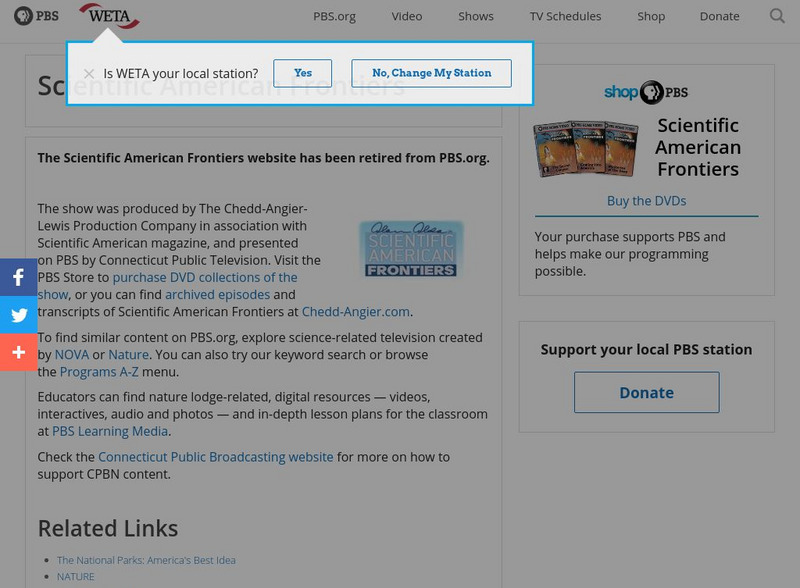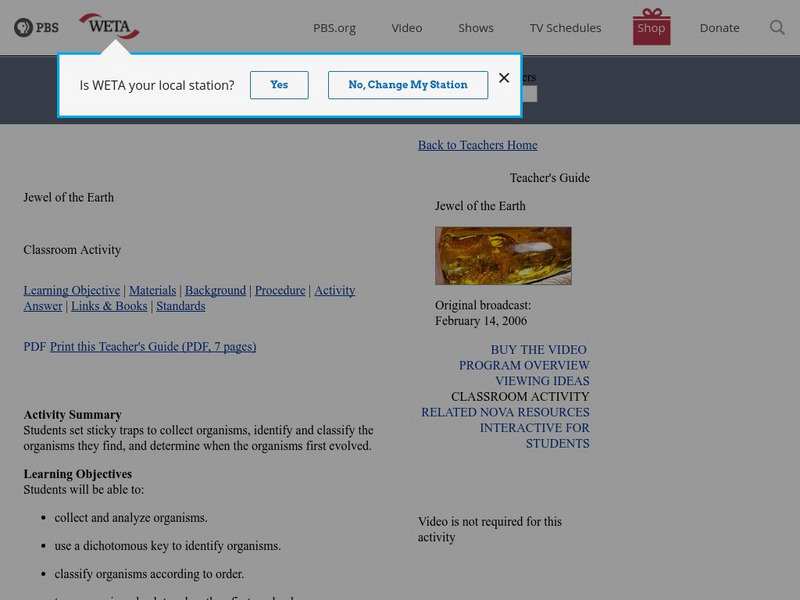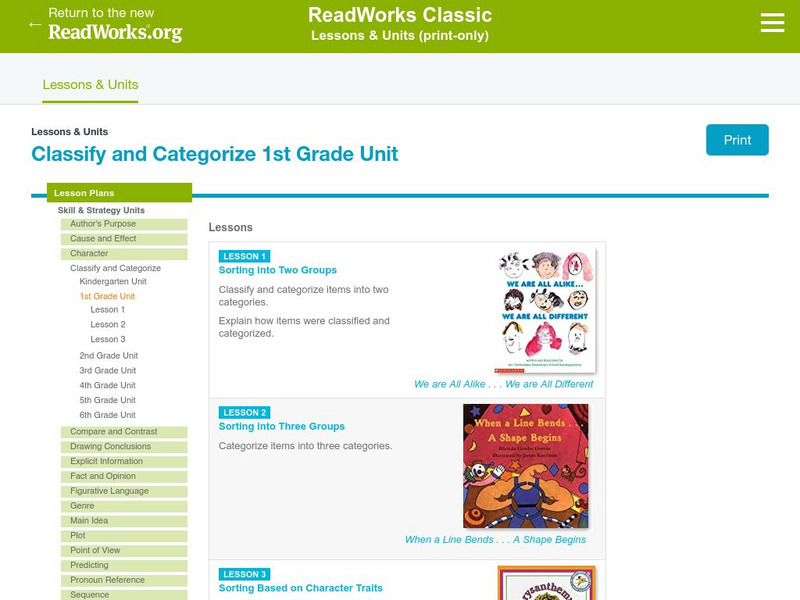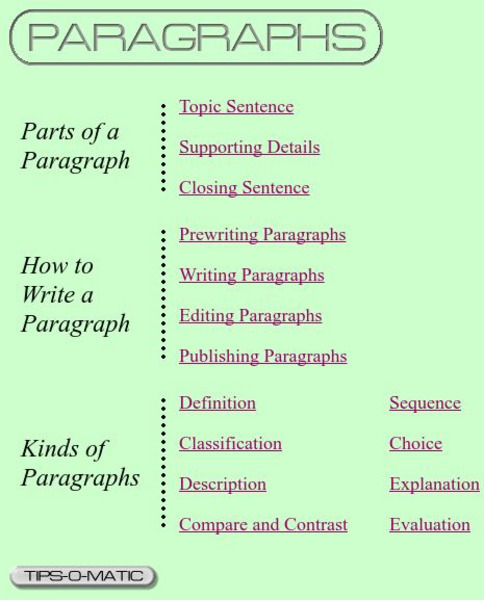Alabama Learning Exchange
Alex: I Know What I Am, but What Are You?
During this lesson students will develop an understanding of how to classify living things and what creates the distinction among them. They will learn to classify living things by effects, environment, and activity.
Estrella Mountain Community College
Online Biology Book: The Nature of Science and Biology
Use the scientific reasoning and critical thinking to take an in-depth look at the basics of biology.
Polk Brothers Foundation Center for Urban Education at DePaul University
De Paul University: Center for Urban Education: I Can Locate and Classify Information [Pdf]
A blank T-Chart is provided for students to use as they sort facts into two categories. Students will classify science information with this aid.
Read Works
Read Works: Classify and Categorize 2nd Grade Unit
[Free Registration/Login Required] A series of three lesson plans designed to teach students to classify and categorize items, characters, and information. The third activity is based on the book Splish! Splash! Animal Baths by April...
Shippensburg University
Shippensburg University: Personality Theories: Jean Piaget
This is an excellent resource on the life and work of the Swiss educational psychologist Jean Piaget (1896-1980).
Read Works
Read Works: Classify and Categorize 4th Grade Unit
[Free Registration/Login Required] A three-lesson plan unit on classifying and categorizing through which students learn how to organize research into an outline, use text features to locate information, and write a research report....
PBS
Pbs Teachers: Scientific American: The Wild West: Nasty Critters
Research the taxonomy, physiology and relatives of scorpions and create a mobile. Explore the stereoscopic senses of pit vipers, and experience how perception can be augmented by causing fluorescent paint to glow with UV light.
PBS
Pbs Teachers: Jewel of the Earth
Collect and analyze organisms and use a dichotomous key to identify and classify the organisms. Research the evolutionary history of organisms.
BiologyWise
Biology Wise: Diatoms Facts
Provides information about diatoms, including their physical characteristics, where they can be found, their classification, how they reproduce, how they form diatomaceous earth when they become fossilized, and their importance to...
Other
Oikos.org: Jean Piaget
"The basic reason for this international attention was the unquestionable fact that Piaget was the founding father of a branch of psychology that tries to unravel the mysteries of the human mind, how it grows and how it comes to know."...
Alabama Learning Exchange
Alex: The Real Number System
This activity focuses on a clear understanding of the real number system by using a variety of teaching strategies. A graphic organizer on a slideshow illustrates how the classifications of numbers relate. A kinesthetic activity helps...
Extreme Science
Extreme Science
Explore the science behind the "extremes" in our world. Organized into sections on earth science, the animal kingdom, technology, and space science, this site opens your eyes to giant creatures, amazing technological advances, vast...
TED Talks
Ted: Ted Ed: Inside the Ant Colony
Ants have one of the most complex social organizations in the animal kingdom; they live in structured colonies that contain different types of members who perform specific roles. Deborah M. Gordon explains the way these incredible...
Biology 4 kids
Biology4 Kids: Sponges the First Invertebrate
Find out about some the most simple organisms in the Animal Kingdom, the sponges.
Other
Maple Syrup Urine Disease: An Overview
Read about the rare inherited disorder affecting newborn babies and children called maple syrup urine disease(MSUD). Including information on how this condition is inherited and how its different forms affect the body, this article is...
Stanford University
Stanford University: Sea Urchin Natural History
Stanford University offers an excellent review of the biology and ecology of sea urchins. After reading the text, try the reproduction/survival game!
National Health Museum
Nhm: Amino Acid Sequences Show Evolution
This lesson plan focuses on differences in the amino acid sequence of hemoglobin and myoglobin proteins. They use the number of differences to create a phylogenetic tree.
Read Works
Read Works: Classify and Categorize 1st Grade Unit
[Free Registration/Login Required] A three-lesson plan unit on classifying and categorizing through which students learn how to sort items into two and three categories and explain how each group is classified. Finally, students...
National Health Museum
Access Excellence: Making a Phylogenetic Tree Lesson Plan
Constructing phylogenetic trees may be a daunting task for students, but this lesson plan is a simulation of what molecular biologists must do to determine relationships. This plan is for students who have a good grasp of DNA structure...
BBC
Bbc: Nature Wildfacts: Dromedary Camel
The world's most common camel is the Dromedary. Find out more on the Dromedary through this detailed fact sheet and photos.
National Health Museum
Nhm: Restriction Maps to Cladograms Lesson
This lesson plan requires students to analyze DNA restriction maps to determine the differences in the sequence for several primates and humans. They then use the information to create a cladogram.
Other
Tidewater Community College: Writing Center: Organizing Paragraphs and Essays
This page gives a quick, but thorough look at a few good ways to organize a piece of writing.
EL Education
El Education: In the Zone: Where the Land Meets the Water
This field guide to the marine organisms of the intertidal zone of Casco Bay was created by 7th grade students in Portland, Maine, as part of a Learning Expedition called, "In the Zone." Students were engaged in scientific research at...
ACT360 Media
Writing Den: Paragraphs
How do you write a paragraph? Use this site to learn more about the different parts of a paragraph.



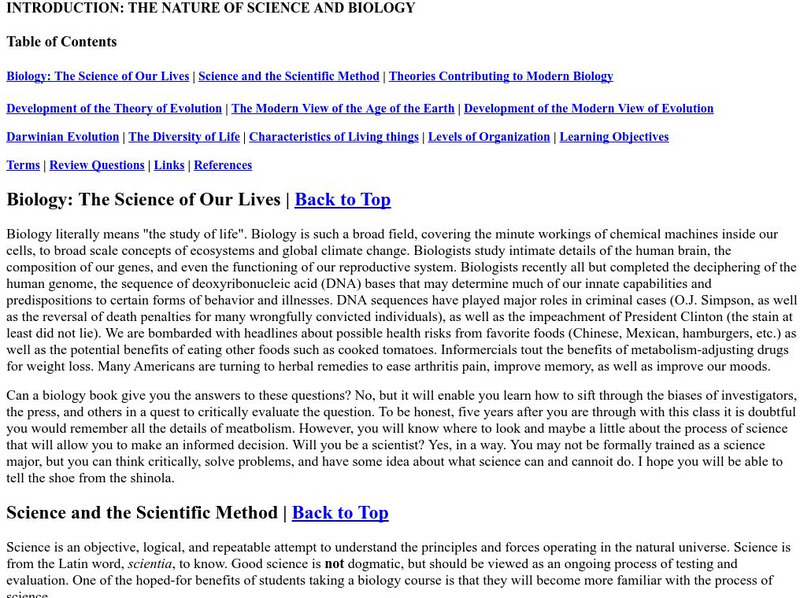
![De Paul University: Center for Urban Education: I Can Locate and Classify Information [Pdf] Graphic De Paul University: Center for Urban Education: I Can Locate and Classify Information [Pdf] Graphic](https://d15y2dacu3jp90.cloudfront.net/images/attachment_defaults/resource/large/FPO-knovation.png)



